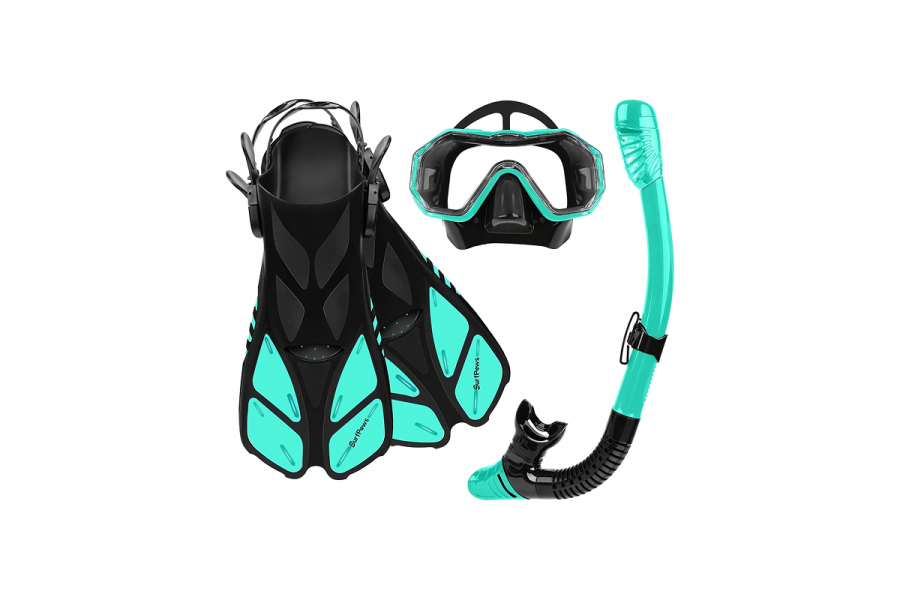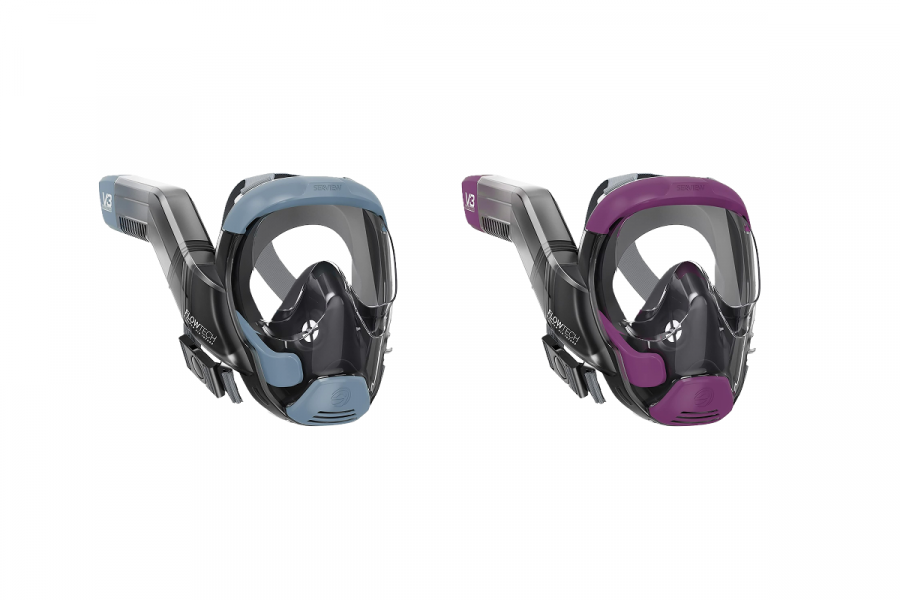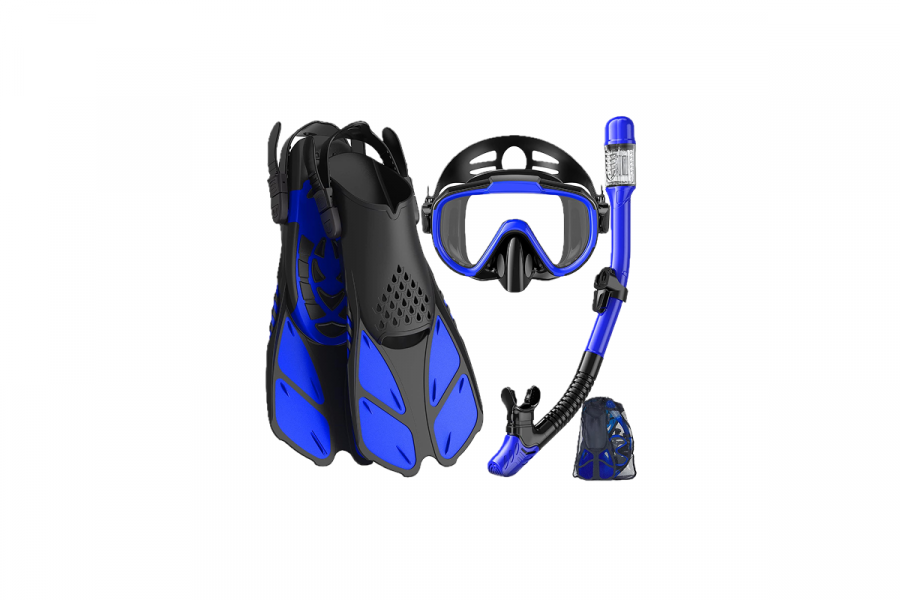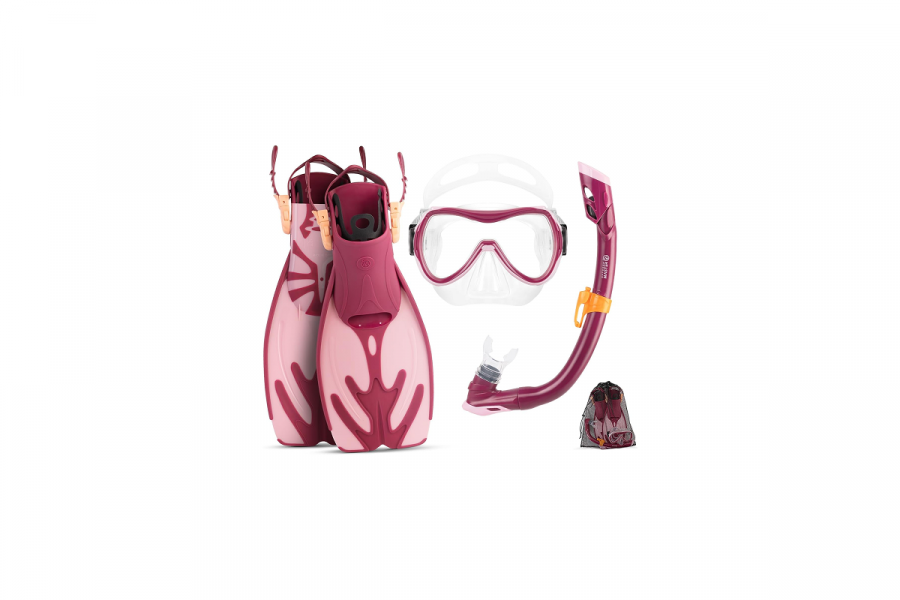Fun fact: Benjamin Franklin invented the first snorkel fin. He never made it to Hawaiʻi, but somehow still played a part in helping people enjoy the islands’ underwater beauty. A bit random, sure—but that’s what popped up while looking into the history of snorkeling in Hawaiʻi.
Turns out, there isn’t much recorded. Maybe it’s because snorkeling here feels like such an obvious thing to do. Crystal-clear water, vibrant marine life—it’s all right there, just waiting to be explored. People have likely been dipping beneath the surface for generations, no explanation needed.
Thinking about snorkeling on your next trip? Master diver Annette Johansson shares a few tips to help you make the most of it — plus, we’ve rounded up a dozen great gear picks to get you started.
Feature Photo: Compiled from Amazon images
Getting Started
There’s no shortage of stunning spots to snorkel around Hawaiʻi. Each island has its gems, but some local favorites include Kealakekua Bay on the Big Island, Kapiolani Park Beach on Oʻahu, Molokini Crater off Maui, and Ke’e Beach Park on Kauaʻi. Wherever the adventure leads, don’t forget to use reef-friendly sunscreen — it helps keep those vibrant coral reefs thriving.
What to expect once you’re in the water? About 20% of the fish here are found only in Hawaiʻi. Keep an eye out for tiny, quirky Scarfaced Blennies, the colorful Potter’s Angelfish, and the bright orange Hawaiʻian Bigeye. And for those hoping to see sea turtles — you’re in luck. Honu, as they’re called in Hawaiian, are a common and magical sight. Just remember: look, don’t touch. Sea turtles are protected by law, and it’s illegal to harass, handle, or harm them in any way. The fines are serious — up to $25,000 and even possible jail time. Best to admire from a respectful distance and let them glide by in peace.
Don’t snorkel solo — always go with a buddy and keep an eye on each other out there. It’s safer and way more fun to share the experience anyway.
Before heading into the water, take a good look at the conditions. Is it choppy? Are the waves picking up? Any reefs, boats, or crowds around that could make getting in and out tricky? Know your limits and play it safe — there’s no rush.
And when you’re out there, look but don’t touch. Some sea creatures bite, sting, or just don’t appreciate the attention. Even the coral is super delicate — just brushing against it can cause damage. So float gently, stay aware, and help keep the reefs healthy for everyone who comes after.
A good mask makes all the difference when snorkeling. It should fit snugly around your eyes and nose — not too tight, just enough to create a seal. You can buy one ahead of time or rent one from pretty much any dive shop on the island. A quick way to check the fit? Gently breathe in through your nose with the mask on (without the strap) — if it sticks to your face without holding it, you’re good to go. Just be sure to move your hair out of the way and check for any gaps where water could sneak in. A little de-fogger will help keep your view nice and clear underwater, too.
The snorkel attaches right to the mask strap and lets you breathe while floating face-down. Here are a dozen solid adult options — click through to check out colors, features, and find one that feels right for you.
Photo: Amazon
This snorkel set is super easy to use and great for sharing. The adjustable fins fit a bunch of sizes, and the soft foot pockets keep things comfortable. The mask stays clear, the snorkel keeps water out, and it all comes in a mesh bag that’s easy to grab and go.
This Amazon customer is a fan:
“This snorkeling gear set is perfect for travel! The adjustable fins are comfortable, the mask stays clear and fog-free, and the dry top snorkel works well. Comes with a handy gear bag, making it easy to pack and go. Ideal for both beginners and experienced snorkelers!”
Photo: Amazon
A lot of reviews call this mask a game changer — and for good reason. Its full-face, transparent design with a flat lens means no distortion, so you can enjoy the underwater view without feeling dizzy. It also makes breathing super easy, thanks to great airflow. And as a bonus, there’s a built-in camera mount so you can capture and relive all your underwater adventures.
This Amazon customer is a fan:
“These mask are game changers when it comes to snorkeling. You never have to worry about snorkel filling with water when you dive under. Mask never fogs. I have a relatively big head and it fits and seals nicely. Well worth the money. Local pool store was selling just swimming goggles for this price. Quality seems like it will last. Bag is nice.”
Photo: Amazon
The JRing snorkel mask gives you a super clear, wide 180° view with tough tempered glass that handles pressure like a champ. It’s perfect for underwater exploring, and the snorkel pops on and off easily whenever you need. Plus, the snorkel has a float ball that moves with you—when you’re underwater, it floats up and seals the valve to keep water out. Once you’re back above water, it drops down so fresh air can flow in.
This Amazon customer is a fan:
“10/10 would recommend these are tempered glass. The snorkel clicks onto the goggles for easy use. We had no issues and it seems like we will get a lot of life out of them. Check out our video we found an octopus!”
Photo: Amazon
The EXP VISION snorkel mask gives you a nice, wide view with its 3-window design, so you can really take in everything around you. The lens is tough and won’t crack under pressure, and the soft silicone skirt fits comfortably on your face. The food-grade silicone mouthpiece fits easily and creates a solid seal—someone even said it worked just fine with a beard (with a little help from some Vaseline).
This Amazon customer is a fan:
“I bought this mask and another to compare. This one was a little less expensive than the other one and performed way better. I used it on a week long trip in Aruba and went swimming every day. Never had issues with fogging or leaking. I did apply some Vaseline to my mustache area which probably helped prevent leaking. I am really impressed with this mask and snorkel combo.”
Photo: Amazon
This snorkel mask makes underwater exploring easy—just breathe naturally with the Flowtech air system, enjoy a full 180° view, and no need to worry about fog. If any water sneaks in, just lift your head and it drains out on its own. There’s even a GoPro mount to capture the view. It works really well and looks great too. It comes in several colors—SeaGlass and Urchin really stand out.
This Amazon customer is a fan:
“This is a game changer. I’ve always had problems with leaky masks, I’ve used mask sealant, and Vaseline, but I must have an odd shaped face. With this one I was able to stay under as long as I wanted. The difference is that this deals with the leak, every time you exhale it pushes out any water that got in. I left my old snorkel and mask at the resort for the next occupants to use, hopefully they have a normal shaped face!”
Photo: Amazon
This 4-in-1 snorkel set has everything you need—adjustable fins, a tempered glass mask, a dry-top silicone snorkel, and a travel bag to keep it all together. It’s easy to pack and perfect for snorkeling, swimming, diving, or whatever water adventure you’ve got planned. Plus, it comes in a few color options so you can pick the one that fits your style.
This Amazon customer is a fan:
“Used our gear in Hawaii for our anniversary! Was nice not to have to rent. Created a good seal, no leaking, no issues! Perfect for what you pay!”
Photo: Amazon
This Amazon customer is a fan:
“Excellent purchase! Tempered glass lenses are very clear under water. Easy to adjust.”
Photo: Amazon
New to snorkeling? This Vengreedo set is a solid choice. It comes with everything you need—mask, dry-top snorkel, and short fins—great for snorkeling, swimming, or even light diving.
This Amazon customer is a fan:
“These are much higher quality than I was expecting for that price. They’re exactly what I was looking for not a really long fin. Much shorter than my scuba diving fins which is perfect for the pool.”
Photo: Amazon
This Amazon customer had this to say:
“First time snorkeling, these items were comfortable , easy to use and adjust, and worked great. Highly recommended.”
Photo: Amazon
This mask comes in sizes for both adults and kids, making it perfect for the whole family. It’s especially great for beginners—no need to learn how to breathe through a snorkel mouthpiece. Just put it on and breathe like you normally do.
This Amazon customer is a fan:
“Purchased this for our vacation to Florida this year. 10/10 recommend this snorkel mask. Allows no water to come back in when you go underwater, and has an evident range of sight. We saw tons of fish, jellyfish, and even a large sea turtle while snorkeling with this mask.”
Photo: Amazon
This Amazon customer is a fan:
“The full-face mask is super comfortable and doesn’t fog up, plus the detachable camera mount is a fun bonus for underwater photos. The water shoes fit great and provide solid support. Perfect for both kids and adults—definitely a solid choice for your next adventure!”
Photo: Amazon
This Amazon customer is a fan:
“Fits perfectly for my 8 year old daughter. She is so picky and loves this swim mask. Can’t wait to use it in the Virgin Islands next year week!”
*We may receive a commission for anything purchased — thank you!
Did we miss your favorite item?
Please let us know at connect@localgetaways.com.














